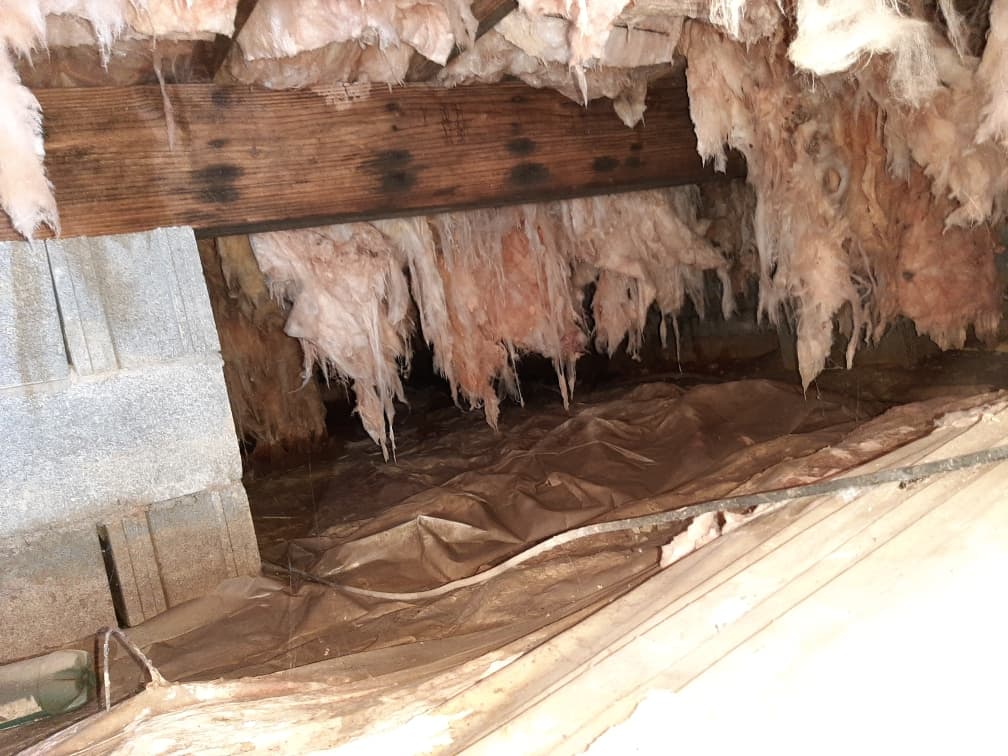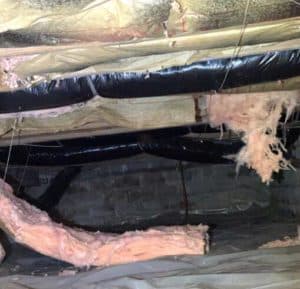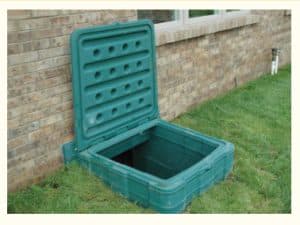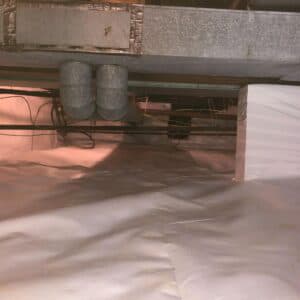
Originally posted 1/5/22; updated 12/15/22
Most people spend very little- if any- time in their home’s crawl space. Given this vacancy, you would expect your crawl space to be clean and bare. But you would be wrong; most crawl spaces have at least some debris (junk, trash, miscellaneous stuff) scattered throughout the area. How does this happen? And does it matter?
These are some of the questions we’re going to tackle in this blog. Acculevel has been in the home repair business for more than 25 years. We specialize in foundation repair and waterproofing, and this means our project advisors spend a lot of time in basements and crawl spaces. In fact, since our start in 1996, we’ve helped over 35,000 homeowners restore their homes to strength, stability, and health.
Debris removal is one of our most commonly performed services, yet it’s rarely discussed. Today, we’re going to break down what debris removal is, why it’s important, and what it costs.
There are some kinds of debris that we expect to find in every crawl space: leaf litter, insulation, and plastic are common. But there is always room for surprises- one homeowner had used tires under his home and has zero clue how they got there! (Squeezing those through the crawl space door was a major challenge, too.)
The most common item we find and remove from a crawl space is fallen fiberglass insulation and its fittings (the hangers and nails that originally held it in place). Why is this so common? Because fiberglass insulation absorbs moisture. Over time, it becomes so weighed down that it begins to sag out of place. Eventually, it pulls free from the fasteners.
We do not recommend that homeowners use fiberglass insulation in their crawl space. Not only because it fails and falls out of place, but also because it retains moisture. Until fiberglass insulation falls down, it holds that dampness against the wooden flooring structure of your home, which is why choosing the best crawl space insulation is essential to prevent these issues.
(Not-so-fun-fact: moisture is the number one cause of sagging floors.)
Spray foam insulation is far more effective, does not absorb moisture, and adheres firmly to your home’s surfaces. This means it stays where we put it and fills all of the cracks and gaps that allow drafts to come in.

This photo was taken by an Acculevel project advisor during a free in-home assessment. The insulation is wet, molding, and falling out of the flooring structure.
We are not exterminators, and we do not have the appropriate equipment or training to handle infestations of any kind. During your initial in-home assessment, our project advisor will look for evidence that insects or animals are living in your crawl space. If this is the case, they will discuss your need for hiring the appropriate professionals to eliminate the invading species.
These unwanted intruders can do major damage, whether they’re nesting in insulation, chewing on electrical, or destroying items like your vapor barrier. Termites are well-known for destroying wood components, and animal waste introduces a wide variety of bacteria and disease into your home.

This photo shows an installed Turtl with the door open. You can see the lid will seal the crawl space closed, and it’s possible to lock this access hatch.
We do offer some options that can discourage or prevent these intrusions, however. One of the best ways to avoid critter invasions is to ensure your crawl space entrance is tightly closed against larger mammals. Acculevel offers steel crawl space doors, as well as a sealed and locking Turtl as options for you. You should also make sure the crawl space vents are screened or shielded to keep out smaller animals.
You may have noticed that (in the photo of falling insulation), you can also see an old vapor barrier on the ground. This is another standard type of debris that we regularly remove for homeowners. Vapor barriers are only effective for 5-10 years before they start to break down.
Like fiberglass insulation, a compromised vapor barrier should be removed before it is replaced. This is one of those instances where more is not better. Layering another barrier on top of a decaying one won’t make the first one more effective. Decomposing plastic can also emit fumes or encourage mildew growth.
The bulk of debris removal is done before any repairs are made. After all, we can’t repair a sagging floor or install water drainage until we have a (relatively) clean slate. And while the majority of the debris occurs naturally, we also have to remove any oddities as well.
At the end of the installation, before we place a vapor barrier on the ground or install encapsulation, we make one more sweep of the crawl space. Our goal is to remove every superfluous item down to the last nail.
There are several reasons why removing debris from your crawl space is an essential step. First and foremost, sharp objects like nails or glass can damage the vapor barrier or encapsulation material. You’re spending your hard-earned money on these items, because they’re going to improve the health and longevity of your home. You don’t want them compromised by a stray piece of metal.
Additionally, those sharp objects can be a hazard to our crew members, to you, or to any tradespeople who need to enter the crawl space for maintenance purposes. Rusty nail punctures require tetanus shots and come with potential infections; these are problems no one needs or wants.
As for the soggy fiberglass insulation, this should be removed to reduce the humidity level in your crawl space. Even if it’s no longer in direct contact with your wooden flooring structure, a damp material will retain moisture and allow bacteria and other organisms to flourish. It can also encourage pests to intrude into your crawl space and use the insulation batting as nesting material.

This photo was taken by an Acculevel crew member, after encapsulating a crawl space. This area is now clean and dry; the homeowner could even use this for additional storage now!
Crawl spaces are small and cramped, which limits mobility and access. This means debris removal is time-consuming and labor intensive. The general cost for debris removal is approximately $3 per square foot. This pricing varies significantly, depending on the specific details of your crawl space and its contents.
We haul away and properly dispose of everything we remove from the job site. Sometimes this may require the work crew to bring a larger container or trailer to hold everything. Certain materials like fiberglass insulation must be handled carefully and disposed of properly, since it’s a hazardous material. Similarly, used tires need to be recycled at designated locations.
Debris removal is not a service we perform as a stand-alone process. We will only remove debris from a crawl space where we are also making repairs or installing other products like waterproofing.
We’ve touched on a number of topics in this FAQ: sagging floors, spray foam insulation, encapsulation, biological growth. If you want more information about any of these products or services- or how to avoid problems that start in your crawl space- you should check out our homeowner’s guide to crawl space repairs.
This guide is free to all homeowners, and is designed to be a helpful resource whenever you encounter a potential warning sign. Bookmark it and refer to it any time you have questions!
If you would like a foundation expert to come to your home and assess your crawl space, contact Acculevel for an appointment. Our service area includes all of Indiana and portions of the surrounding states; you can find an interactive map here.
Don’t live within our service area? Please make sure the contractor you hire is properly insured and accredited by the Better Business Bureau. You are also welcome to use our guide of questions to ask a contractor. This is another free resource we’ve developed, to help homeowners find a repair company that is reputable, ethical, and will treat you with respect.
[DISPLAY_ULTIMATE_SOCIAL_ICONS]